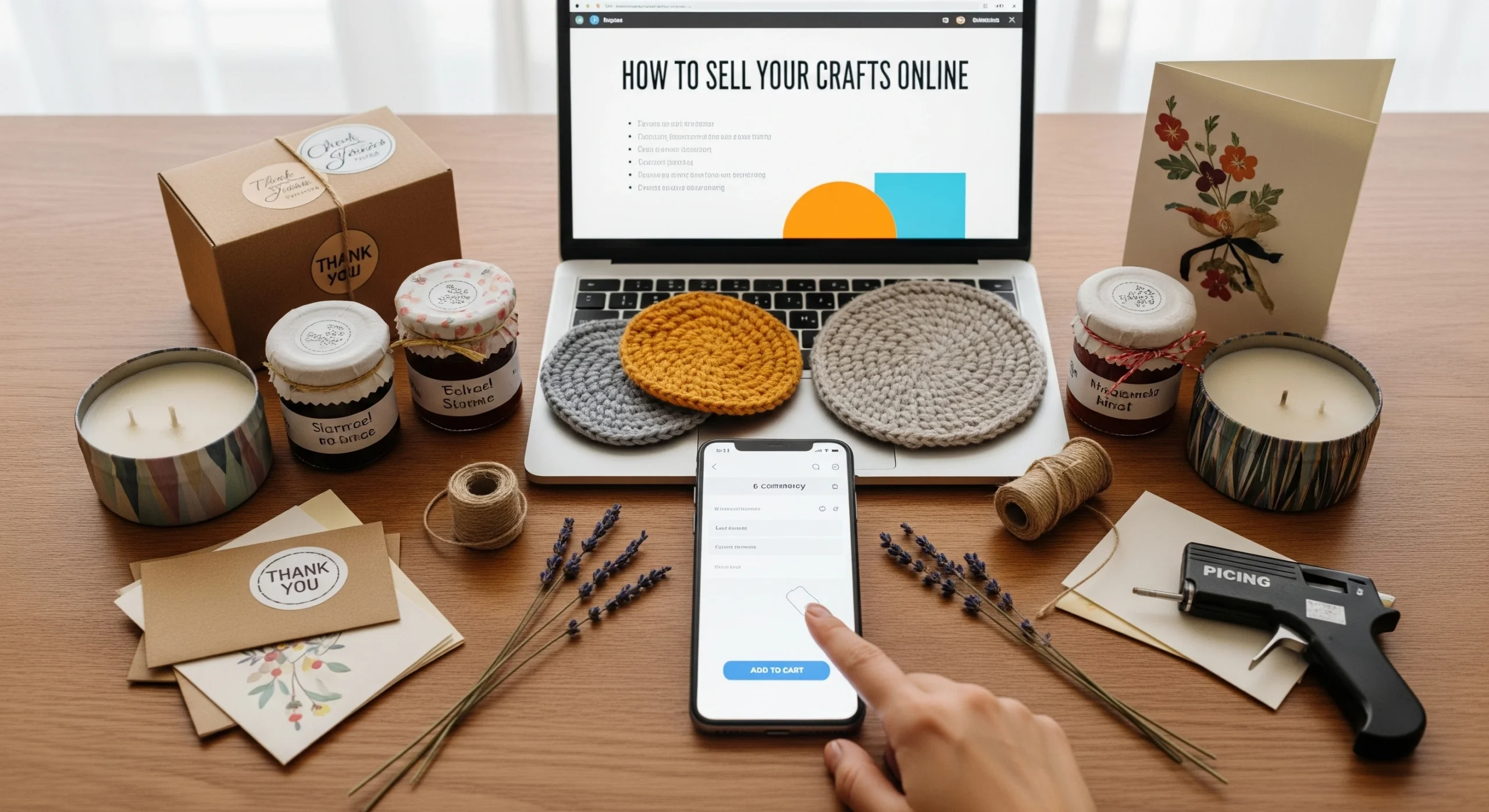Really, selling homemade products online can be profitable—if you choose the right products, platforms, and marketing strategies. Many people turn their hobbies into thriving businesses from home, especially with the rise of ecommerce tools and marketplaces.
Check How to
Sell Homemade Products Online
If you like to sell homemade products online, You can start small on existing marketplaces or build your own e-commerce store as your brand grows.
Same time, You can sell a wide variety of homemade products online—from crafts and decor to food and digital goods. The key is choosing items that are in demand, easy to produce, and have good profit margins.

People are more interested in selling products online because it’s easier, cheaper, and reaches more customers than traditional retail. The shift is driven by convenience, global access, and the ability to start with minimal investment.
Choose Where to Sell
You can sell your homemade creations in two primary ways. One method is using digital platforms that connect you with existing buyers, offering convenience and exposure. The other approach is building a personal website or shop, where you can design, manage, and promote your products while establishing a unique brand identity.
Online marketplaces
Platforms such as Amazon Handmade, Etsy, eBay, and Itsy Bitsy already attract large audiences, giving sellers better product visibility — though competition can be intense. Amazon Handmade, in particular, offers an easy setup process, access to a global customer base, and dedicated support for artisans from India and beyond.
Your own online store
Another option is building a personal storefront through platforms like Shopify, Indiemade, or Squarespace. This approach allows complete control over branding, design, and customer experience. Shopify remains a popular choice thanks to its built-in tools for payments, shipping, and marketing — helping small handmade businesses grow their online presence with ease.
What are the product can i sell online?
Here’s a curated list of popular and profitable homemade products you can sell online in 2025:
🎨 Crafts & DIY Kits
- Handmade candles (especially scented or themed)
- Soap and bath bombs with natural ingredients
- Resin art like coasters, trays, and jewelry
- DIY craft kits for kids or adults (e.g., embroidery, painting)
👗 Fashion & Accessories
- Crocheted or knitted items (scarves, hats, bags)
- Handmade jewelry (beaded, wire-wrapped, clay)
- Custom T-shirts using heat transfer or embroidery
- Upcycled fashion from old clothes or denim
🏠 Home & Decor
- Macramé wall hangings or plant holders
- Wooden signs or furniture accents
- Decorative planters or pots
- Hand-painted mugs or dishes
🍪 Food & Beverages
- Baked goods (cookies, cakes, bread)
- Jams, pickles, or spice blends
- Homemade chocolates or candies
- Artisan coffee or tea blends
💻 Digital & Printable Products
- Printable planners or journals
- Wall art or greeting cards (PDFs)
- Digital stickers for planners or social media
- Ebooks or guides on niche topics
🧘 Wellness & Beauty
- Essential oil blends or rollers
- Herbal teas or bath salts
- Natural skincare products (lip balms, scrubs)
- Aromatherapy kits
🐶 Pet Products
- Homemade pet treats
- Pet clothing or accessories
- Custom pet portraits or tags
These ideas are drawn from current ecommerce trends and marketplaces like Etsy, Shopify, and Amazon Handmade. If you’d like help narrowing down options based on your skills or interests, I can help you brainstorm a personalized product list.
How to Sell Homemade Products Online
Turning homemade creations into a thriving online business is easier than ever — but success starts with the right plan. Here’s a clear, step-by-step breakdown to help craft a brand, attract buyers, and start selling confidently.
Step 1: Identify a Niche
The first step is to focus on a specific product category such as soaps, jewelry, candles, or home décor. A defined niche helps attract a loyal audience, makes marketing more effective, and allows consistent storytelling across all channels.
Step 2: Validate the Idea
Before launching, it’s essential to check market demand. Exploring platforms like Etsy, Amazon Handmade, and Instagram can reveal what’s trending and what’s oversaturated. Tools such as Google Trends or marketplace search bars are helpful for spotting opportunities and measuring interest.
Step 3: Build a Brand Identity
A strong brand goes beyond a logo. It represents the business’s personality and promise. Creating a memorable name, cohesive visuals, and consistent tone across packaging and online presence helps a handmade shop stand out from competitors and builds customer trust.
Step 4: Set Up a Store or Marketplace Profile
Once the products and branding are ready, it’s time to establish an online storefront. Marketplaces like Etsy or Amazon Handmade provide instant access to large audiences, while independent platforms such as Shopify, WooCommerce, or Squarespace allow full creative and operational control. Detailed descriptions, professional photos, and well-set prices play a key role in making listings shine.
Step 5: Capture High-Quality Product Photos
Good photography can make or break online sales. Clear, well-lit images help customers visualize products in real life. Lifestyle shots, multiple angles, and clean backgrounds can significantly boost conversion rates and enhance brand credibility.
Step 6: Price for Profitability
Setting prices involves more than covering material costs. Labor, packaging, shipping, and platform fees must be included to ensure sustainability. A profit margin of around 30–50% keeps operations healthy and allows room for growth.
Step 7: Promote the Brand
Marketing turns visibility into sales. Social media platforms such as Instagram, Facebook, and Pinterest are powerful tools for storytelling and engagement. Consistent posting, collaborations with creators, and seasonal promotions can expand reach and build a loyal following.
Step 8: Manage Fulfillment Efficiently
Efficient fulfillment ensures smooth customer experiences. Automated tools and fulfillment services like the Shopify Fulfillment Network help streamline shipping, track orders, and reduce delays. Branded, eco-friendly packaging adds a professional touch that leaves a lasting impression.
Step 9: Gather Feedback and Improve Continuously
After launching, collecting customer reviews is invaluable. Feedback highlights what works and what needs improvement. Updating listings, enhancing quality, and adjusting strategies based on insights keeps the business evolving and competitive.
Tips for Successful Selling of Homemade Products
Starting small and staying consistent with quality, branding, and communication are the keys to successfully selling homemade products online. Absolutely! Those are excellent strategies. Let me expand on them and add a few more to help you succeed in selling homemade products online:
1. Build an Email List or Online Community
- Use newsletters to share product launches, behind-the-scenes content, and exclusive offers.
- Create a Facebook group or Instagram page to engage with loyal customers.
- Offer a small discount or freebie in exchange for email sign-ups.
2. Participate in Local Craft Fairs
- Great for testing products and getting direct feedback.
- Hand out business cards or QR codes linking to your online store.
- Use events to collect emails and build your local following.
3. Experiment with Multiple Selling Channels
- Try Etsy, Shopify, Amazon Handmade, and social media shops.
- Track which platform gives you the best traffic, conversion, and profit.
- Once you find your sweet spot, invest more in that channel.
4. Optimize Product Listings
- Use high-quality photos with good lighting and multiple angles.
- Write clear, benefit-focused descriptions with keywords for SEO.
- Include customer reviews and testimonials to build trust.
5. Offer Limited Editions or Seasonal Products
- Create urgency and excitement with time-sensitive items.
- Tie products to holidays, festivals, or trending themes.
6. Use Packaging to Reinforce Your Brand
- Include thank-you notes, care instructions, or small freebies.
- Make your packaging Instagram-worthy to encourage sharing.
7. Track Your Metrics
- Monitor sales, traffic sources, and customer behavior.
- Use tools like Google Analytics, Etsy Stats, or Shopify Insights.
8. Stay Consistent and Keep Learning
- Post regularly on social media and update your store often.
- Follow trends, take online courses, and join maker communities.
Is Selling Homemade Products Profitable?
Yes, Selling homemade products can be highly profitable, but several key factors influence success.
- Low startup costs make it accessible, as most handmade items require minimal investment to begin.
- Scalable production—such as creating products in batches or automating certain steps—helps improve profit margins over time.
- A strong niche appeal also matters; unique, customized, or limited-edition products often command higher prices and attract loyal buyers.
- The platform choice plays a big role too: running an independent website avoids marketplace fees but demands more effort in marketing and audience building.
Finally, consistency in launching new products and engaging with customers builds trust, repeat sales, and long-term growth. According to recent reports, the homemade product market is thriving in 2025, offering countless profitable opportunities across crafts, art, food, and even digital goods.
Top Reasons People Prefer Selling Homemade Items Online
People are more interested in selling products online because it’s easier, cheaper, and reaches more customers than traditional retail. The shift is driven by convenience, global access, and the ability to start with minimal investment.
Here’s why online selling has become the go-to choice for entrepreneurs and creators:
1. Low Startup Costs
- No need to rent physical space or hire staff.
- Many platforms (like Etsy, Shopify, Amazon) offer affordable plans or free listings.
2. Global Reach
- Sellers can reach customers across the country—or the world—24/7.
- Online stores are not limited by geography or store hours.
3. Convenience & Flexibility
- Sellers can manage their business from home or on the go.
- You can update listings, fulfill orders, and communicate with customers anytime.
4. Scalability
- Easy to expand product lines or increase inventory.
- Digital tools help automate tasks like inventory tracking, marketing, and shipping.
5. Data & Insights
- Online platforms provide analytics to track sales, customer behavior, and trends.
- Sellers can make smarter decisions based on real-time data.
6. Marketing Opportunities
- Social media, email campaigns, and SEO help attract customers.
- Influencer partnerships and paid ads can boost visibility quickly.
7. Pandemic Shift
- COVID-19 accelerated the move to online shopping, making digital storefronts essential.
- Contactless transactions became the norm, and many habits stuck post-pandemic.
8. Customer Preferences
- Buyers love the convenience of browsing and purchasing from home.
- Online shopping offers more variety, better prices, and easy comparisons.
Selling online isn’t just a trend—it’s a transformation in how business is done. If you’re thinking about starting, I can help you choose the best platform or product niche based on your goals. Want to explore that next?





Leave a Reply to A WordPress Commenter Cancel reply